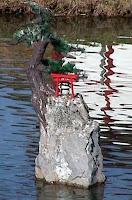 |
| Autumn Colors along the Biwako Canal. |
This post will be images taken over the seven-years of living in Japan.
 |
| Yours Truly at Kyotango,Kyoto Prefecture. |
 |
| Katsuragawa River Arashiyama |
The Katsuragawa River runs through the very-popular tourist destination of Arashiyama. But it's not just the Autumn colors that are abound here, the Sakura are also a spectacle to see/experience.Map.
 |
| Hydrangea Flowers at Chushojima. |
During my research for my "Everytrail Guide" -
 |
| Canal Boat on Takasegawa Canal. |
 |
| Choken-ji Temple Gate. |
Directly opposite your boarding-point, is the Choken-ji Temple with it's red earthen walls surrounding the complex.Map.
 |
| Hydrangeas with Jizo-in Temple. |
Just up the road, or rail-line, from Chushojima, is Uji City, one of my favorite cities in Japan.
Not too touristy, but popular none-the-less.The city was made famous by the novel "The Tale of Genji" where the final chapters are set.
 |
| Mountain Road. |
 |
| Weekend in Shiga. |
 |
| Autumn Colors in Shiga. |
 |
| Sculptures at Kaga-Onsen. |
 |
| On the pond at Kaga-Onsen. |
 |
| Entrance to Konzo-ji Temple. |
You like isolated places?
 |
| Gardens, Konzo-ji temple. Kyoto. |
 |
| Waterwheel at Banpakukinenkoen. |
 |
| Gate, entrance to Kontai-ji Temple. |
Well I think that just about covers "Autumn in Japan". I will sign-off with one last image that encapsulates all that is Japan, two Maiko amongst the Autumn foliage in Kyoto.








































